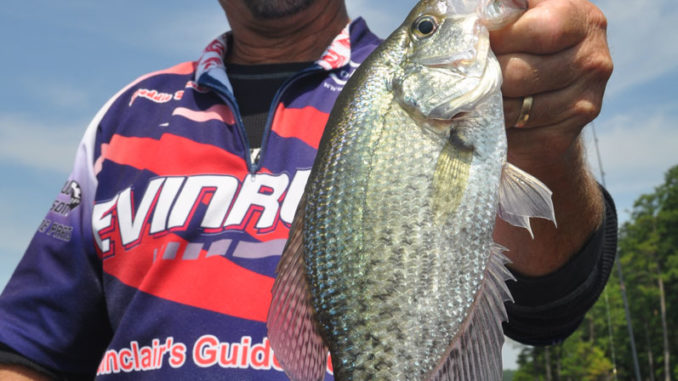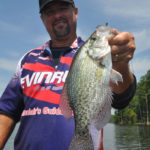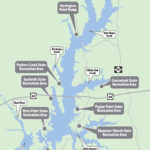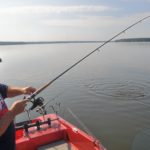
Slow-trolling jigs and minnows along creek-channel ledges should produce Jordan Lake slabs.
Happily for crappie fishermen, Jordan Lake has recovered from a massive 2011 fish kill. The rare combination of a cold-weather threadfin shad die-off that February, then a week of 100-degree temperatures that July wiped out a lot of fish.
The next spring, crappie fishing was awful; it got a little better in the spring of 2013. The lake’s veteran crappie chasers now say Jordan’s slabs are back. In fact, they had typical Jordan crappie fishing last fall, according to guide Freddie Sinclair.
“(Last) October … people were catching plenty of 13- and 14-inch fish at Jordan Lake,” he said.
That translates into 1 1/2- to 1 3/4-pound fish. Bigger slabs are likely to show up this fall, he said.
Another top crappie fisherman, Rod King of Durham, also believes Jordan Lake’s black crappie have rebounded.
“The quality was there this spring, even if the size wasn’t quite what it used to be,” he said. “But when I go back this fall, they should be even bigger.”
Most people target crappie in large impoundments during the spring spawning period, when fish are shallow. But October is totally different, although the fishing techniques are similar.
“All that changes is you’re moving from shallow fishing, for the most part, to deep fishing,” King said. “It just takes some cold nights and the sun to get down in sky for fish to move to deep water from the dam to (US) 64,” King said.
Sinclair agreed.
“I go to the main channel from Farrington to the (US 64) bridge,” he said. “It funnels water from one end of the lake to the other, all the way to the dam. It also contains nutrients and other stuff that baitfish feed on, and that makes predators collect in the channel.
“There’s also some structure just outside the channel — humps and road beds on the north side of the bridge — ledges and stuff.”
King said shad will migrate in the channel this month before heading toward shallow water. He fishes sweet spots that exist along the channel and near it.
“I’m looking for stumps or rock and fish suspended off that stuff,” he said. “That’s where I usually catch those fish in the fall. One other thing that’s kind of against the norm — sometimes crappies will go in to feed in shallow water in the mornings. I’ve caught them in the backs of creeks in 5 to 6 feet of water during the fall. But that depends on wind direction. It has to (blow into the creeks), and it has to blow that way for three to five days in a row. It pushes shad back there, and the crappie follow them.”
Sinclair counted on that kind of pattern before the fish kill. Back in 2011, before the long heat wave, he fished in the shallows and caught plenty of fish that normally would have been in the deeper waters of New Hope Creek but weren’t.
“We had all those 100-degree days in 2011, and a warm winter,” he said. “Crappie and other fish moved into shallow water, and we caught them on main-lake points and in pockets in the backs of coves in December.”
Sinclair spends so much time on the lake, even in hot conditions, he noticed something very few fishermen discovered that summer.
“The lake level got down 4 feet,” he said, “so on this one bank, grass grew up 1- to 1 1/2-feet tall. Then the rains came and flooded that bank and grass, so bass and baitfish got in the grass, along with some crappie. As time went on, a lot of crappie were in 3 to 5 feet of water, just off that grass bank. I found a little pocket in a cove up near Farrington, with all those fish. I saw only two older gentlemen fishing up there.
“Before I started fishing there, I wasn’t catching crappie anywhere on the lake, but I remembered I’d found fish at that bank, probably in late August. I kept going back, and the fish always would be there — and they were still there in October. They kind of stayed back there up until Christmas. But if we have cold spells this fall, the crappie will be out on the main lake channel and not in shallow water.”
Sinclair fished for those shallow crappies with a technique called tight-lining. It combines multiple rods and lures and moving so slowly jigs or minnows on the end of the 4- or 6-pound lines remained nearly vertical.
“The rule is 50-50 for trolling lures and baits at specified depths,” King said. “If you’re fishing in, for example, 8 feet of water, you’d try to keep your baits 4 feet down.”
Slow-trolling prevents many hangups. King and Sinclair have fished across all of Jordan Lake’s acres and know what’s under their boats almost all the time. Even if depth finders were outlawed, they probably could catch crappie in shallow water.
But out on the main-lake in October, it’s another ballgame, because as temperatures fall, so do crappie — they fall into deep water.
“If I didn’t have my depth finder, it would be tough,” King said. “I’m not worried so much about getting lures and baits snagged on stuff as I am about finding fish, then getting my baits down to them, because those fish will be suspended from 12 to 17 feet deep — not on any particular structure, but above it.”
Sinclair likes fishing a “fall-winter pattern” because crappies stack up in schools over the deeper channels.
“I’ll use a double rig at times, but most of the time, I like a single rig tipped with a minnow,” he said.
Whether or not Sinclair uses a weight depends on the size of his crappie jigs. He likes 1/32-ounce jigs tipped with crappie minnows. Obviously, trolling such light jigs in deep water would be impossible unless Sinclair employed another weight.
“I like to start with 1/4-ounce egg sinkers and short leaders, 2 to 2 ½ feet long,” he said. “I use enough weights to keep the line straight down. I use my trolling motor and sometimes the wind to pull my boat from 1/2 to 5/8 mph. It’s very slow trolling, but (that speed) keeps lures and baits almost straight down and lines tight.”
Thus the name, tight-lining.
Sinclair employs Southern Crappie rods in 8- to 16-foot lengths and reels spooled with 6-pound monofilament and the same size for his leaders.
“I like a No. 2 gold or red hook, and 12 to 14 inches above that, I’ll put a BB shot,” he said. “Sometimes, depending on the wind direction and current, I might put a 1/4- or 1/2-ounce egg sinker above the BB shot. The split shot keeps the egg sinker in place. I use the egg sinker to keep the baits straight down.”
When he’s using jigs and live minnows, Sinclair likes to use jigs from 1/32- to 1/8-ounce. But sometimes, he ties a 1/4-ounce jig at the end of his line and tips it with a crappie minnow.
Color choices for his lures are pegged to water clarity.
“In October, usually it’s the water at Jordan that makes me decide on the color of my lures and my line strength,” Sinclair said. “Jordan’s water is usually tea color, so I like chartreuse, orange, browns and reds. Sometimes I mix up my colors, like a chartreuse head and an orange body. That combination seems to work good.”
Because of high-nutrient levels caused by run-off from upstream that drains into Jordan’s main two feeder streams, the Haw River and New Hope Creek, the lake rarely has clear water. The depths that sunlight will penetrate vary only from 1 to 2 feet.
“I never use 4-pound line at Jordan,” Sinclair said. “At some lakes with clear water, I might drop down to 4-pound line, but at Jordan I like 6-pound because you want to be able to land a big crappie — and sometimes you even might have a largemouth bass, catfish or striper hit a crappie jig or minnow. That’s not rare at all. In that water, 6-pound line is just as invisible as 4-pound line.”
Sinclair agreed with King that New Hope Creek, starting around Farrington Bridge and extending 11 miles downstream to its confluence with the Haw River is a highway to crappie heaven during early fall.
“Up around Farrington Point can be really good in October,” Sinclair said. “A few of the lake points will be good to try, too.”
King said “Crappie generally are near the channel at the Farrington and US 64 bridges during October. Between those two bridges, the river channel also has fish suspended between 15 and 18 feet.”
That means king will slow-troll 16 rods tipped with jigs or jig-and-minnow combinations.
“October fishing is different, and it’s better than the spring,” King said, “because crappie have only one thing on their minds — feedin’ up for the winter. In the spring, they have breeding on their minds. I like it better when I know they just want to eat.”
King’s favorite fall jig sizes and colors include 1/8- to 1/16-ounce jigs and natural shad colors with some chartreuses and reds.
King always tips his jigs with live minnows and sometimes runs combo rigs with a minnow-tipped 1/8-ounce jig at the end of a line, then adds a solo curlytail grub on a 1/32- or 1/16-ounce jig on a dropper line off a three-way swivel a couple feet above the jig and minnow.
“I also like my outside rod to just bump the edge of the channel break,” he said. “If there are stumps or rocks at a ledge, they often hold fish.”
Since crappie are designed to see baits above them, King also trolls his other lures and minnows using the 50-50 rule — he will sets lures to run 12 feet over 24- to 25-foot bottoms.
The only differences between the tactics Sinclair and King employ are the brands of rods they use and the size of the line.
“I’m still using B ’n’ M crappie poles, and I always fish 4-pound line,” said King, who spools the line on 1900 and 2100 series Quantum spinning reels. “I believe I get more strikes with 4-pound line.”
October means “a lot of big sacks of fish,” he said.
Sinclair said fishermen began catching 13- and 14-inch fish at Jordan last October, and he expects more of those size fish will be available during 2014.
“I (showed) a good place to a friend who wanted to take his daughter fishing for crappie at Jordan,” he said. “He called me back and said they had a blast, caught their limit, and had caught three 14-inch crappie.
“So Jordan’s coming back.”
DESTINATION INFORMATION
HOW TO GET THERE/WHEN TO GO — US 64, which crosses North Carolina from west to east, bisects Jordan Lake between Pittsboro and Apex. NC 751 is good access to the lake from Durham, Chapel Hill and points north, and it crosses US 1 a few miles southeast of Jordan Dam. Fishing is good from September through October and into early November.
BEST LURES — Crappie jigs from 1/32- to 1/4-ounce in combination with soft-plastic curlytail grubs in chartreuse and a mix of reds, browns, white, black and red, tipped with a live minnow.
BEST TECHNIQUES — Use depth finders to search for ledges holding schools of baitfish along the New Hope Creek channel from Farrington Bridge to its confluence with the Haw River, concentrating at the Farrington and US 64 bridges. Slow-troll jigs or jigs and minnows using the 50-50 rule — if water depth is 24 feet, set boat speed at 1/2 mph to allow slow-trolled lures to come through water at 12 feet deep.
GUIDES/FISHING INFO — Freddie Sinclair, Sinclair’s Guide Service, 919-533-4547; Wilsonville General Store, 919-362-7101; U.S. Army Corps of Engineers, 919-542-4501.
ACCOMMODATIONS — Camping is available at Jordan Lake State Recreation Area, 919-362-0586; Hampton Inn and Suites, Holly Springs, 800-230-4134; Comfort Inn, Apex, 800-997-5148; Holiday Inn Express, Apex, 800-997-5149.
MAPS — Fishing Hot Spots, 800-500-MAPS; Kingfisher Maps, 800-326-0257, www.kfmaps.com; GMCO Maps, 888-420-6277, www.gmcomaps.com.







